CADILLAC ESCALADE 2008 3.G Owners Manual
Manufacturer: CADILLAC, Model Year: 2008, Model line: ESCALADE, Model: CADILLAC ESCALADE 2008 3.GPages: 490, PDF Size: 2.65 MB
Page 311 of 490
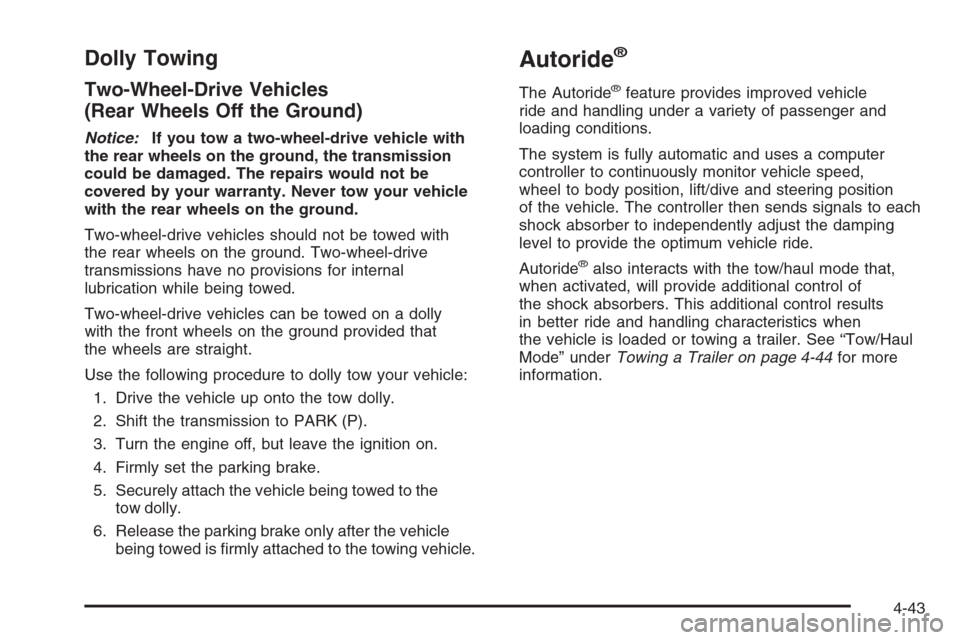
Dolly Towing
Two-Wheel-Drive Vehicles
(Rear Wheels Off the Ground)
Notice:If you tow a two-wheel-drive vehicle with
the rear wheels on the ground, the transmission
could be damaged. The repairs would not be
covered by your warranty. Never tow your vehicle
with the rear wheels on the ground.
Two-wheel-drive vehicles should not be towed with
the rear wheels on the ground. Two-wheel-drive
transmissions have no provisions for internal
lubrication while being towed.
Two-wheel-drive vehicles can be towed on a dolly
with the front wheels on the ground provided that
the wheels are straight.
Use the following procedure to dolly tow your vehicle:
1. Drive the vehicle up onto the tow dolly.
2. Shift the transmission to PARK (P).
3. Turn the engine off, but leave the ignition on.
4. Firmly set the parking brake.
5. Securely attach the vehicle being towed to the
tow dolly.
6. Release the parking brake only after the vehicle
being towed is �rmly attached to the towing vehicle.
Autoride®
The Autoride®feature provides improved vehicle
ride and handling under a variety of passenger and
loading conditions.
The system is fully automatic and uses a computer
controller to continuously monitor vehicle speed,
wheel to body position, lift/dive and steering position
of the vehicle. The controller then sends signals to each
shock absorber to independently adjust the damping
level to provide the optimum vehicle ride.
Autoride
®also interacts with the tow/haul mode that,
when activated, will provide additional control of
the shock absorbers. This additional control results
in better ride and handling characteristics when
the vehicle is loaded or towing a trailer. See “Tow/Haul
Mode” underTowing a Trailer on page 4-44for more
information.
4-43
Page 312 of 490
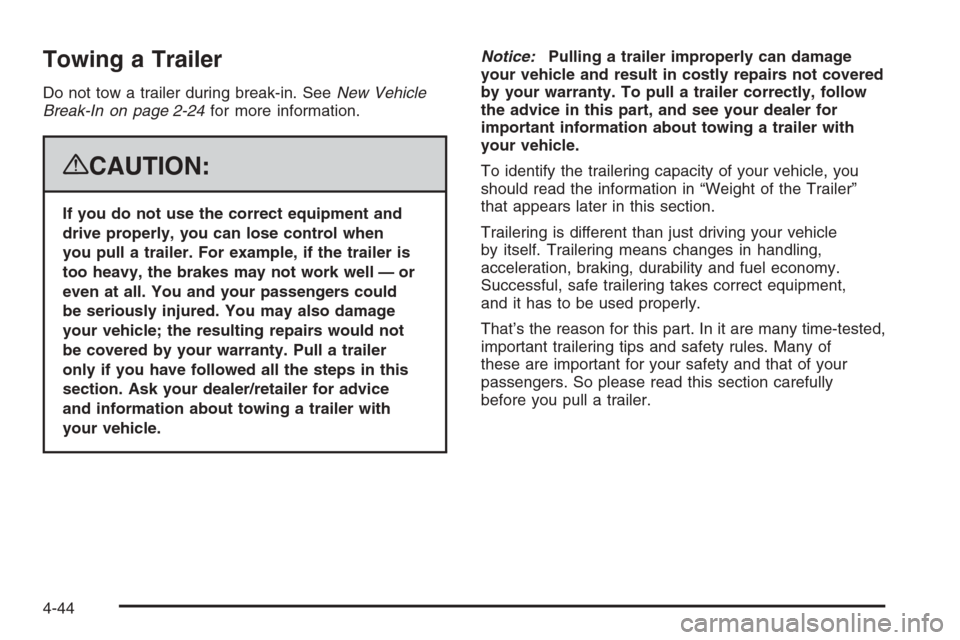
Towing a Trailer
Do not tow a trailer during break-in. SeeNew Vehicle
Break-In on page 2-24for more information.
{CAUTION:
If you do not use the correct equipment and
drive properly, you can lose control when
you pull a trailer. For example, if the trailer is
too heavy, the brakes may not work well — or
even at all. You and your passengers could
be seriously injured. You may also damage
your vehicle; the resulting repairs would not
be covered by your warranty. Pull a trailer
only if you have followed all the steps in this
section. Ask your dealer/retailer for advice
and information about towing a trailer with
your vehicle.Notice:Pulling a trailer improperly can damage
your vehicle and result in costly repairs not covered
by your warranty. To pull a trailer correctly, follow
the advice in this part, and see your dealer for
important information about towing a trailer with
your vehicle.
To identify the trailering capacity of your vehicle, you
should read the information in “Weight of the Trailer”
that appears later in this section.
Trailering is different than just driving your vehicle
by itself. Trailering means changes in handling,
acceleration, braking, durability and fuel economy.
Successful, safe trailering takes correct equipment,
and it has to be used properly.
That’s the reason for this part. In it are many time-tested,
important trailering tips and safety rules. Many of
these are important for your safety and that of your
passengers. So please read this section carefully
before you pull a trailer.
4-44
Page 313 of 490
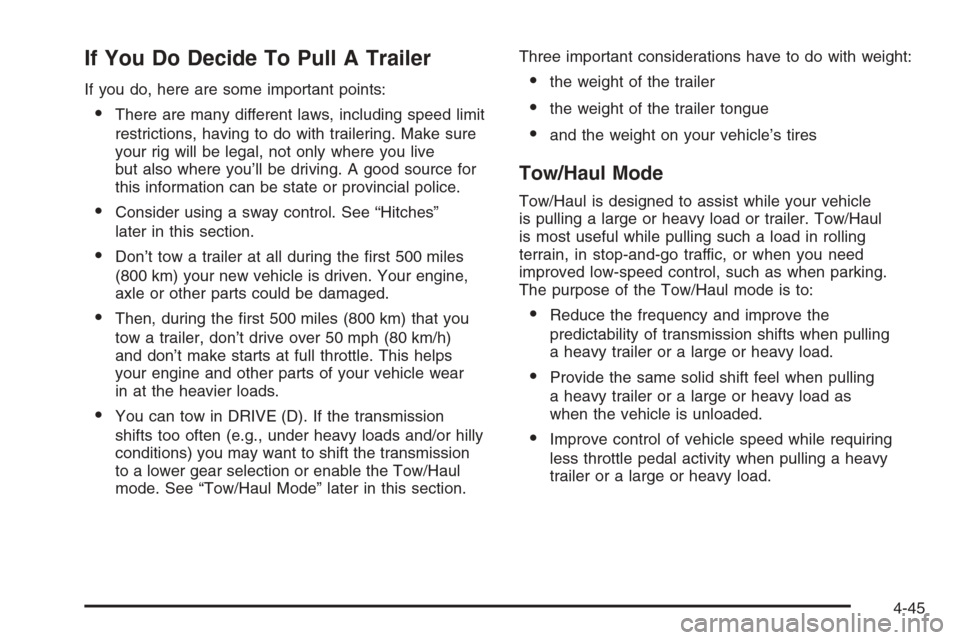
If You Do Decide To Pull A Trailer
If you do, here are some important points:
There are many different laws, including speed limit
restrictions, having to do with trailering. Make sure
your rig will be legal, not only where you live
but also where you’ll be driving. A good source for
this information can be state or provincial police.
Consider using a sway control. See “Hitches”
later in this section.
Don’t tow a trailer at all during the �rst 500 miles
(800 km) your new vehicle is driven. Your engine,
axle or other parts could be damaged.
Then, during the �rst 500 miles (800 km) that you
tow a trailer, don’t drive over 50 mph (80 km/h)
and don’t make starts at full throttle. This helps
your engine and other parts of your vehicle wear
in at the heavier loads.
You can tow in DRIVE (D). If the transmission
shifts too often (e.g., under heavy loads and/or hilly
conditions) you may want to shift the transmission
to a lower gear selection or enable the Tow/Haul
mode. See “Tow/Haul Mode” later in this section.Three important considerations have to do with weight:
the weight of the trailer
the weight of the trailer tongue
and the weight on your vehicle’s tires
Tow/Haul Mode
Tow/Haul is designed to assist while your vehicle
is pulling a large or heavy load or trailer. Tow/Haul
is most useful while pulling such a load in rolling
terrain, in stop-and-go traffic, or when you need
improved low-speed control, such as when parking.
The purpose of the Tow/Haul mode is to:
Reduce the frequency and improve the
predictability of transmission shifts when pulling
a heavy trailer or a large or heavy load.
Provide the same solid shift feel when pulling
a heavy trailer or a large or heavy load as
when the vehicle is unloaded.
Improve control of vehicle speed while requiring
less throttle pedal activity when pulling a heavy
trailer or a large or heavy load.
4-45
Page 314 of 490
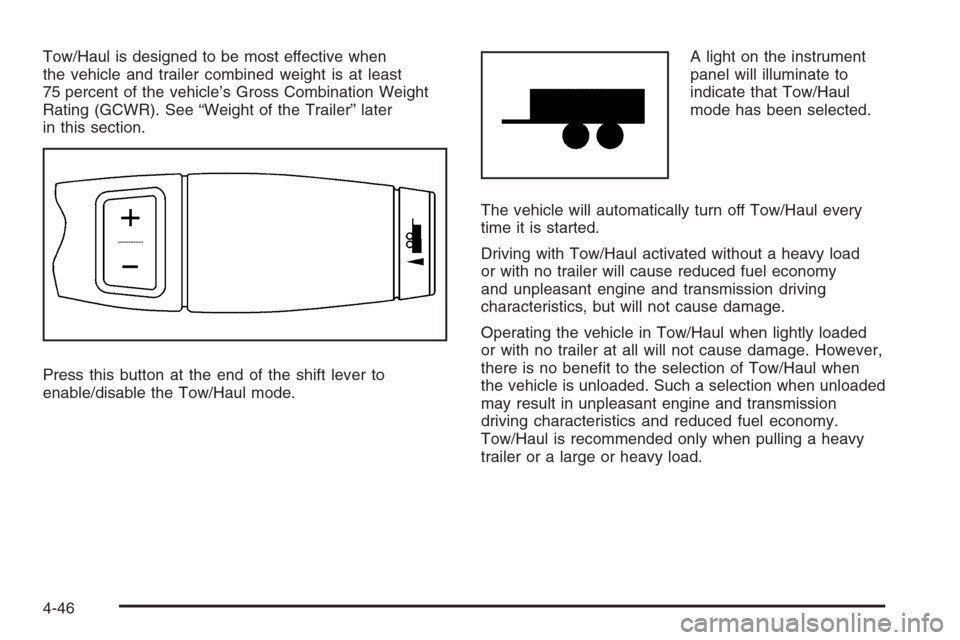
Tow/Haul is designed to be most effective when
the vehicle and trailer combined weight is at least
75 percent of the vehicle’s Gross Combination Weight
Rating (GCWR). See “Weight of the Trailer” later
in this section.
Press this button at the end of the shift lever to
enable/disable the Tow/Haul mode.A light on the instrument
panel will illuminate to
indicate that Tow/Haul
mode has been selected.
The vehicle will automatically turn off Tow/Haul every
time it is started.
Driving with Tow/Haul activated without a heavy load
or with no trailer will cause reduced fuel economy
and unpleasant engine and transmission driving
characteristics, but will not cause damage.
Operating the vehicle in Tow/Haul when lightly loaded
or with no trailer at all will not cause damage. However,
there is no bene�t to the selection of Tow/Haul when
the vehicle is unloaded. Such a selection when unloaded
may result in unpleasant engine and transmission
driving characteristics and reduced fuel economy.
Tow/Haul is recommended only when pulling a heavy
trailer or a large or heavy load.
4-46
Page 315 of 490
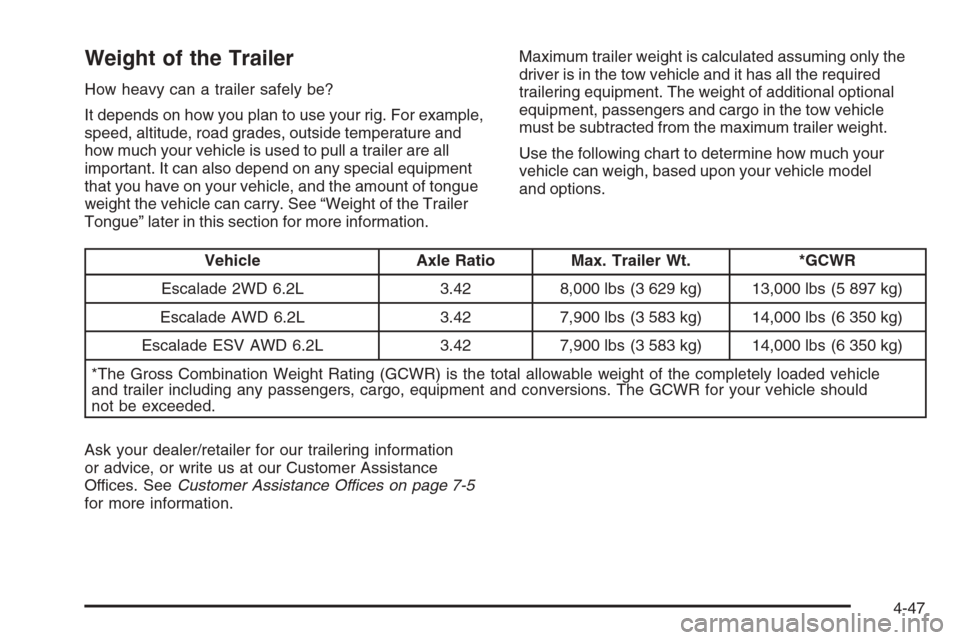
Weight of the Trailer
How heavy can a trailer safely be?
It depends on how you plan to use your rig. For example,
speed, altitude, road grades, outside temperature and
how much your vehicle is used to pull a trailer are all
important. It can also depend on any special equipment
that you have on your vehicle, and the amount of tongue
weight the vehicle can carry. See “Weight of the Trailer
Tongue” later in this section for more information.Maximum trailer weight is calculated assuming only the
driver is in the tow vehicle and it has all the required
trailering equipment. The weight of additional optional
equipment, passengers and cargo in the tow vehicle
must be subtracted from the maximum trailer weight.
Use the following chart to determine how much your
vehicle can weigh, based upon your vehicle model
and options.
Vehicle Axle Ratio Max. Trailer Wt. *GCWR
Escalade 2WD 6.2L 3.42 8,000 lbs (3 629 kg) 13,000 lbs (5 897 kg)
Escalade AWD 6.2L 3.42 7,900 lbs (3 583 kg) 14,000 lbs (6 350 kg)
Escalade ESV AWD 6.2L 3.42 7,900 lbs (3 583 kg) 14,000 lbs (6 350 kg)
*The Gross Combination Weight Rating (GCWR) is the total allowable weight of the completely loaded vehicle
and trailer including any passengers, cargo, equipment and conversions. The GCWR for your vehicle should
not be exceeded.
Ask your dealer/retailer for our trailering information
or advice, or write us at our Customer Assistance
Offices. SeeCustomer Assistance Offices on page 7-5
for more information.
4-47
Page 316 of 490
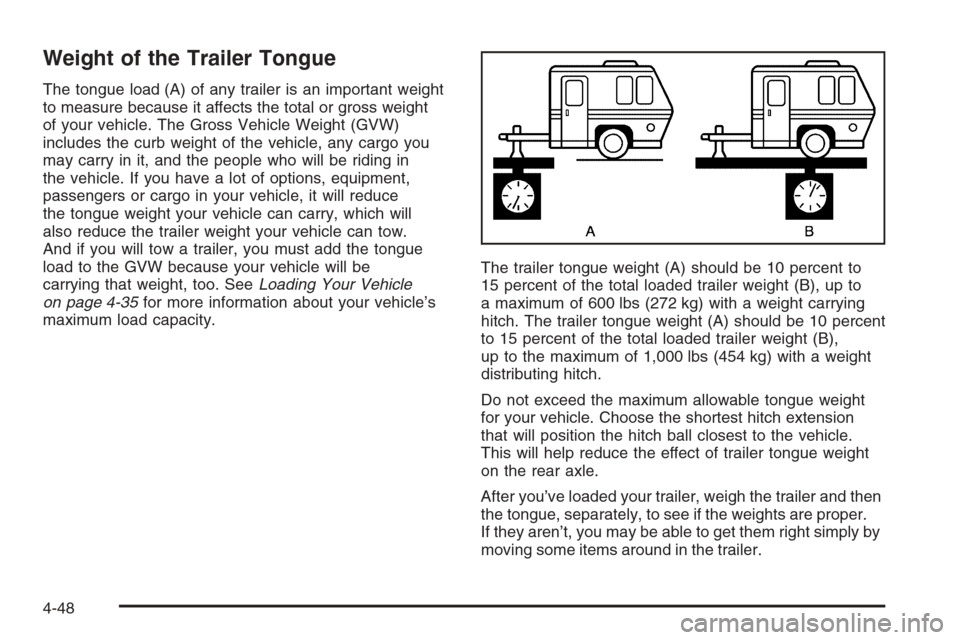
Weight of the Trailer Tongue
The tongue load (A) of any trailer is an important weight
to measure because it affects the total or gross weight
of your vehicle. The Gross Vehicle Weight (GVW)
includes the curb weight of the vehicle, any cargo you
may carry in it, and the people who will be riding in
the vehicle. If you have a lot of options, equipment,
passengers or cargo in your vehicle, it will reduce
the tongue weight your vehicle can carry, which will
also reduce the trailer weight your vehicle can tow.
And if you will tow a trailer, you must add the tongue
load to the GVW because your vehicle will be
carrying that weight, too. SeeLoading Your Vehicle
on page 4-35for more information about your vehicle’s
maximum load capacity.The trailer tongue weight (A) should be 10 percent to
15 percent of the total loaded trailer weight (B), up to
a maximum of 600 lbs (272 kg) with a weight carrying
hitch. The trailer tongue weight (A) should be 10 percent
to 15 percent of the total loaded trailer weight (B),
up to the maximum of 1,000 lbs (454 kg) with a weight
distributing hitch.
Do not exceed the maximum allowable tongue weight
for your vehicle. Choose the shortest hitch extension
that will position the hitch ball closest to the vehicle.
This will help reduce the effect of trailer tongue weight
on the rear axle.
After you’ve loaded your trailer, weigh the trailer and then
the tongue, separately, to see if the weights are proper.
If they aren’t, you may be able to get them right simply by
moving some items around in the trailer.
4-48
Page 317 of 490
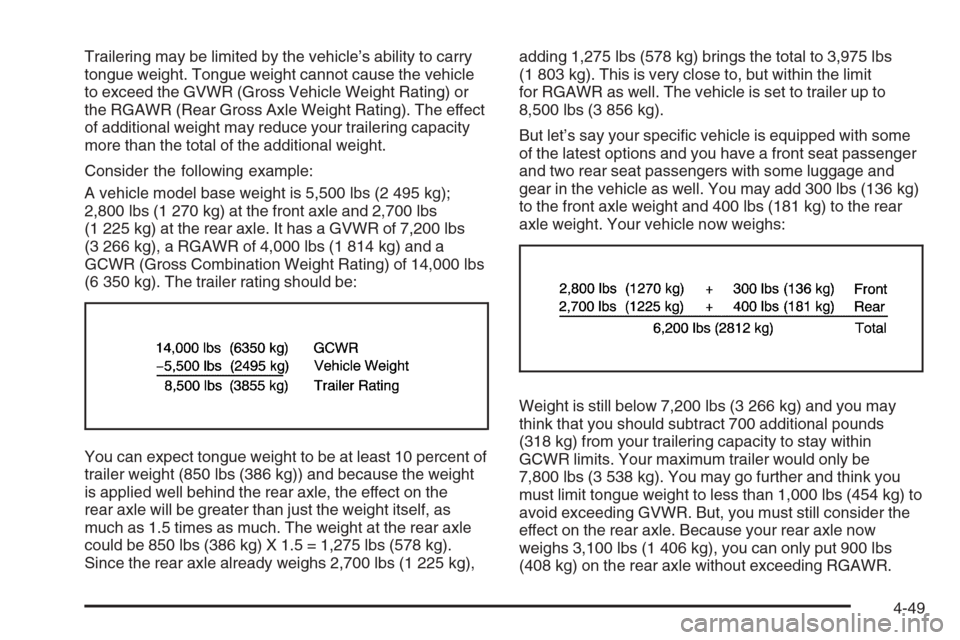
Trailering may be limited by the vehicle’s ability to carry
tongue weight. Tongue weight cannot cause the vehicle
to exceed the GVWR (Gross Vehicle Weight Rating) or
the RGAWR (Rear Gross Axle Weight Rating). The effect
of additional weight may reduce your trailering capacity
more than the total of the additional weight.
Consider the following example:
A vehicle model base weight is 5,500 lbs (2 495 kg);
2,800 lbs (1 270 kg) at the front axle and 2,700 lbs
(1 225 kg) at the rear axle. It has a GVWR of 7,200 lbs
(3 266 kg), a RGAWR of 4,000 lbs (1 814 kg) and a
GCWR (Gross Combination Weight Rating) of 14,000 lbs
(6 350 kg). The trailer rating should be:
You can expect tongue weight to be at least 10 percent of
trailer weight (850 lbs (386 kg)) and because the weight
is applied well behind the rear axle, the effect on the
rear axle will be greater than just the weight itself, as
much as 1.5 times as much. The weight at the rear axle
could be 850 lbs (386 kg) X 1.5 = 1,275 lbs (578 kg).
Since the rear axle already weighs 2,700 lbs (1 225 kg),adding 1,275 lbs (578 kg) brings the total to 3,975 lbs
(1 803 kg). This is very close to, but within the limit
for RGAWR as well. The vehicle is set to trailer up to
8,500 lbs (3 856 kg).
But let’s say your speci�c vehicle is equipped with some
of the latest options and you have a front seat passenger
and two rear seat passengers with some luggage and
gear in the vehicle as well. You may add 300 lbs (136 kg)
to the front axle weight and 400 lbs (181 kg) to the rear
axle weight. Your vehicle now weighs:
Weight is still below 7,200 lbs (3 266 kg) and you may
think that you should subtract 700 additional pounds
(318 kg) from your trailering capacity to stay within
GCWR limits. Your maximum trailer would only be
7,800 lbs (3 538 kg). You may go further and think you
must limit tongue weight to less than 1,000 lbs (454 kg) to
avoid exceeding GVWR. But, you must still consider the
effect on the rear axle. Because your rear axle now
weighs 3,100 lbs (1 406 kg), you can only put 900 lbs
(408 kg) on the rear axle without exceeding RGAWR.
4-49
Page 318 of 490
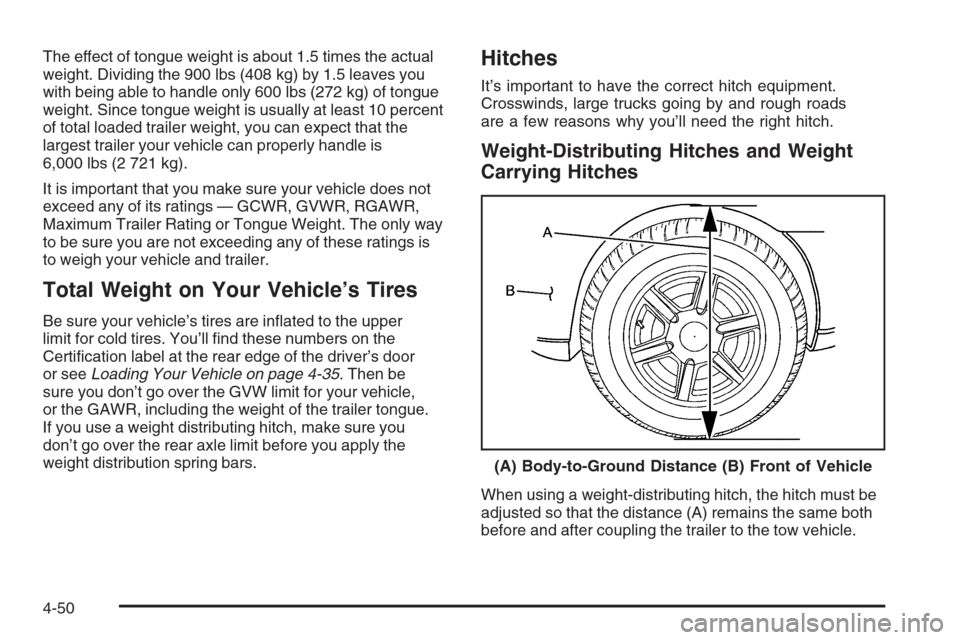
The effect of tongue weight is about 1.5 times the actual
weight. Dividing the 900 lbs (408 kg) by 1.5 leaves you
with being able to handle only 600 lbs (272 kg) of tongue
weight. Since tongue weight is usually at least 10 percent
of total loaded trailer weight, you can expect that the
largest trailer your vehicle can properly handle is
6,000 lbs (2 721 kg).
It is important that you make sure your vehicle does not
exceed any of its ratings — GCWR, GVWR, RGAWR,
Maximum Trailer Rating or Tongue Weight. The only way
to be sure you are not exceeding any of these ratings is
to weigh your vehicle and trailer.
Total Weight on Your Vehicle’s Tires
Be sure your vehicle’s tires are in�ated to the upper
limit for cold tires. You’ll �nd these numbers on the
Certi�cation label at the rear edge of the driver’s door
or seeLoading Your Vehicle on page 4-35. Then be
sure you don’t go over the GVW limit for your vehicle,
or the GAWR, including the weight of the trailer tongue.
If you use a weight distributing hitch, make sure you
don’t go over the rear axle limit before you apply the
weight distribution spring bars.
Hitches
It’s important to have the correct hitch equipment.
Crosswinds, large trucks going by and rough roads
are a few reasons why you’ll need the right hitch.
Weight-Distributing Hitches and Weight
Carrying Hitches
When using a weight-distributing hitch, the hitch must be
adjusted so that the distance (A) remains the same both
before and after coupling the trailer to the tow vehicle.(A) Body-to-Ground Distance (B) Front of Vehicle
4-50
Page 319 of 490
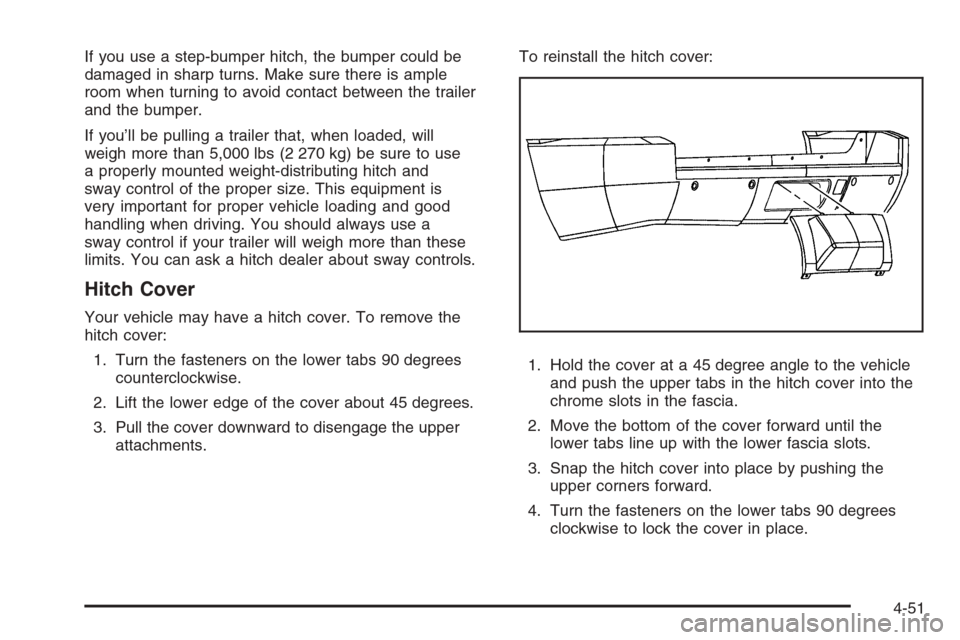
If you use a step-bumper hitch, the bumper could be
damaged in sharp turns. Make sure there is ample
room when turning to avoid contact between the trailer
and the bumper.
If you’ll be pulling a trailer that, when loaded, will
weigh more than 5,000 lbs (2 270 kg) be sure to use
a properly mounted weight-distributing hitch and
sway control of the proper size. This equipment is
very important for proper vehicle loading and good
handling when driving. You should always use a
sway control if your trailer will weigh more than these
limits. You can ask a hitch dealer about sway controls.
Hitch Cover
Your vehicle may have a hitch cover. To remove the
hitch cover:
1. Turn the fasteners on the lower tabs 90 degrees
counterclockwise.
2. Lift the lower edge of the cover about 45 degrees.
3. Pull the cover downward to disengage the upper
attachments.To reinstall the hitch cover:
1. Hold the cover at a 45 degree angle to the vehicle
and push the upper tabs in the hitch cover into the
chrome slots in the fascia.
2. Move the bottom of the cover forward until the
lower tabs line up with the lower fascia slots.
3. Snap the hitch cover into place by pushing the
upper corners forward.
4. Turn the fasteners on the lower tabs 90 degrees
clockwise to lock the cover in place.
4-51
Page 320 of 490
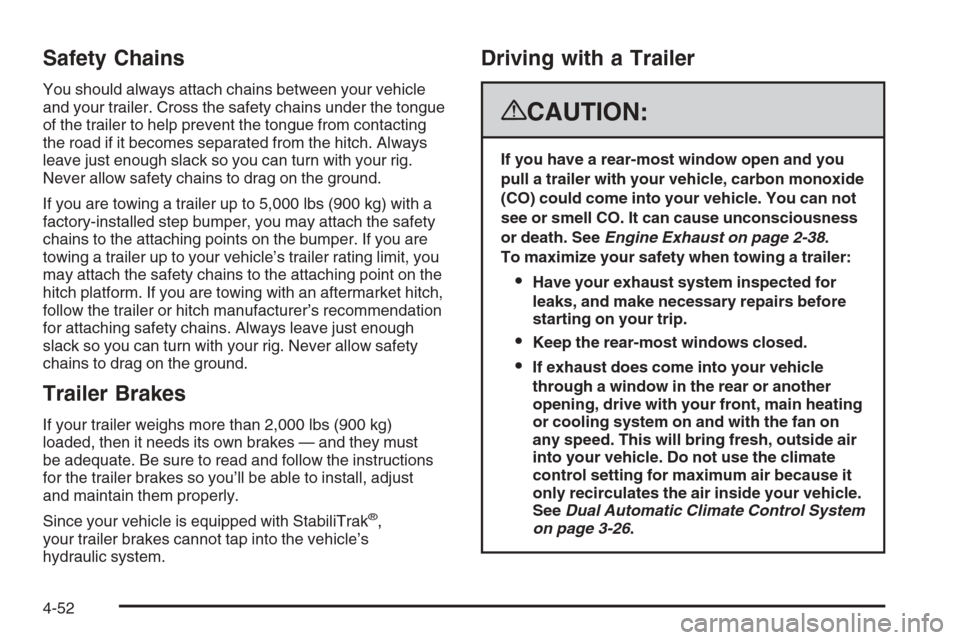
Safety Chains
You should always attach chains between your vehicle
and your trailer. Cross the safety chains under the tongue
of the trailer to help prevent the tongue from contacting
the road if it becomes separated from the hitch. Always
leave just enough slack so you can turn with your rig.
Never allow safety chains to drag on the ground.
If you are towing a trailer up to 5,000 lbs (900 kg) with a
factory-installed step bumper, you may attach the safety
chains to the attaching points on the bumper. If you are
towing a trailer up to your vehicle’s trailer rating limit, you
may attach the safety chains to the attaching point on the
hitch platform. If you are towing with an aftermarket hitch,
follow the trailer or hitch manufacturer’s recommendation
for attaching safety chains. Always leave just enough
slack so you can turn with your rig. Never allow safety
chains to drag on the ground.
Trailer Brakes
If your trailer weighs more than 2,000 lbs (900 kg)
loaded, then it needs its own brakes — and they must
be adequate. Be sure to read and follow the instructions
for the trailer brakes so you’ll be able to install, adjust
and maintain them properly.
Since your vehicle is equipped with StabiliTrak
®,
your trailer brakes cannot tap into the vehicle’s
hydraulic system.
Driving with a Trailer
{CAUTION:
If you have a rear-most window open and you
pull a trailer with your vehicle, carbon monoxide
(CO) could come into your vehicle. You can not
see or smell CO. It can cause unconsciousness
or death. SeeEngine Exhaust on page 2-38.
To maximize your safety when towing a trailer:
Have your exhaust system inspected for
leaks, and make necessary repairs before
starting on your trip.
Keep the rear-most windows closed.
If exhaust does come into your vehicle
through a window in the rear or another
opening, drive with your front, main heating
or cooling system on and with the fan on
any speed. This will bring fresh, outside air
into your vehicle. Do not use the climate
control setting for maximum air because it
only recirculates the air inside your vehicle.
SeeDual Automatic Climate Control System
on page 3-26.
4-52